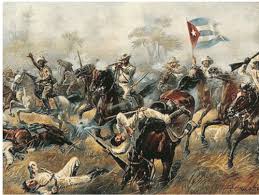On October 10, 1868, Cuban patriot and lawyer Carlos Manuel de Cespedes (1819-1874) freed his slaves and took the Cubans into arms, the first founding event for the Cuban National Liberation Struggles.
The ringing of the bell at his sugar mill La Demajagua, Manzanillo, in the east of the country, meant 145 years ago a triumph of the independence ideas, against the Hispanic fundamentalism and the reformist and annexationist movements.
Cespedes’ gesture was ahead of the arrest of the conspirators under an order of Captain-General Francisco Lersundi, which would have delayed the process indefinitely.
That morning the patron saint of Bayamo pronounced the declaration of independence known as the Manifesto de la Junta Revolucionaria de la Isla de Cuba( Cuban Island Revolutionary Body declaration) or Manifesto del 10 de Octubre (October 10th Declaration) .
At the sugar mill of La Demajagua, before some 500 gathered, he said: “Citizens, sun that you see rising through the summit of Turquino comes to light the first day of freedom and independence of Cuba.”
Thus began this first independence war that lasted 10 years and had a national-liberating, democratic and anti-slavery character. A patriotic national consciousness among the Cubans matured, and although the slave oligarchy remained subject to Spain, the Cuban nation was founded forever.
The strong weight of slavery in the colonial economy allowed Spain to keep Cuba chained when most of the Spanish-American countries reached their independence. According to data of 1862, from a total of 1 million 359 thousand inhabitants, some 500 thousand were of the so-called people of color, the supposed danger that the colonialist ideologues wielded to stop the emancipating movement.
At the time of the revolutionary outbreak, the slave population amounted to more than 300,000 men and women, more than 70 percent in the western region. There were also around 200 thousand mulattos and free blacks (41.3 percent in the West, 20, 5 percent in the center and 38.2 percent in the East).
Cespedes erased that ghost from the Cuban stage by greeting his slaves who were free at that time and inviting other present owners who did the same.”Citizens,” he exclaimed, “until this moment you have been my slaves. From now on, you are as free as I am.
Cuba needs all its children to win independence! ” “Those who want to follow me, to follow me; those who want to stay, you can stay, everyone will remain as free as others.”
The issue of the abolition of slavery triumphed in the heart of the 1968 Revolution and in article 24 of the Guaimaro Constitution the principle was expressed “All the inhabitants of the Republic are entirely free”.
Cubans had the right to freedom and independence because, as Cespedes said, “When a people come to the extreme of degradation and misery in which we see ourselves, no one can disapprove of them using their weapons to put an end to such a state of complete opprobrium … ”
“Cuba,” he affirmed, “aspires to be a great and civilized nation, to lay a friendly arm and a fraternal heart to other peoples …”
The revolutionary struggle begun on October 10, 1868, was seconded in other regions of the country and although it did not achieve its goal of independence and abolition of slavery, it decisively influenced the history of Cuba.
It was followed by the so-called Chiquita War (1879-1880) and the War of Independence (1895-1898), organized by Jose Marti.
According to Fidel Castro, there is only one Cuban Revolution from Cespedes to the present day, including the one that triumphed in January 1959.
(Translated by Yeney Perez Corona)


Deje un comentario